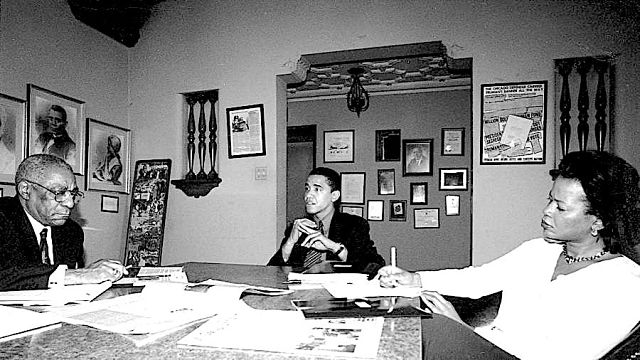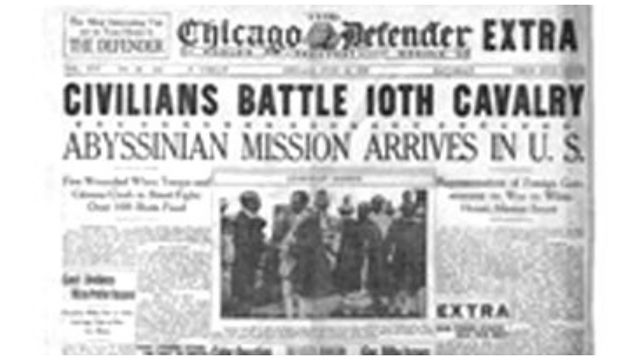 From left, Chicago Defender publisher Eugene Scott, a young Barack Obama, and reporter Beverly Reed at a meeting before his first race for Congress in 2000. (Credit: Chicago Defender Charities Photo)
From left, Chicago Defender publisher Eugene Scott, a young Barack Obama, and reporter Beverly Reed at a meeting before his first race for Congress in 2000. (Credit: Chicago Defender Charities Photo)
Tadias Magazine
By Tadias Staff
Updated: June 11th, 2020
New York (TADIAS) – Since 1905 The Chicago Defender — one of America’s oldest Black newspapers — has been at the forefront of the civil rights movement. For 115 years they have covered issues in Black communities across the United States, profiled leaders from MLK and Jesse Jackson to Barack Obama long before mainstream America recognized their names.
In fact it was a reporter from The Chicago Defender that had confronted the first Ethiopian diplomatic delegation to the U.S. one hundred years ago last summer peppering them with questions regarding their views on the social and political condition of African Americans. Among the newspaper’s highly skilled writers at the time was the acclaimed Novelist, Social Activist and Poet Langston Hughes who continued to contribute opinion articles for the paper throughout the 1940s and 50s.
According to Wikipedia The Chicago Defender was distributed as a daily newspaper starting in 1956 and remained so until 2008 when it was converted into a weekly publication. In 2019 It stopped print publication and transformed into an online newspaper.
The Chicago Defender, along with The Pittsburgh Courier a well as the New York-based Amsterdam News, was also among the leading African American newspapers that had expansively covered the indignant reaction of African Americans to Fascist Italy’s invasion of Ethiopia during World War II with reporting contributed by notable writers including Ethel Payne, Ida B. Wells, Gwendolyn Brooks and Willard Motley.

A headline by the Chicago Defender announcing the arrival of the first Ethiopian diplomatic delegation to the United States on July 11, 1919.
Below is a review of the book ‘The Defender: How the Legendary Black Newspaper Changed America’ that was republished this week by the Oklahoma-based newspaper The City Sentinel. The newspaper notes that the “review first appeared..during the 2016 campaign season” adding that “as journalism faces collapsing business models and other mounting challenges, and in the midst of another presidential election year, the themes explored in the review remain, we hope, worthy of consideration.” The republication of the review continues to resonate and remain relevant today.
—-
Honoring ‘The Defender’ – One of America’s most consequential newspapers – and hoping for a new generation of independent voices
Rarely does any one book capture a city and one of its most vital institutions as well as ‘The Defender: How the Legendary Black Newspaper Changed America’. (The book is still widely available online or at fine bookstores.)
This tale of the Chicago newspaper founded by Robert Sengstacke Abbott in 1905 arcs, as the book’s sub-sub-title summarizes, “From the age of the Pullman Porters to the Age of Obama.”
Eventually passing into the control of Robert’s larger family, The Defender newspaper stayed in the control of his kinfolk until less than a decade ago. This is rarity in modern journalism.
Ethan Michaeli tells the story more or less chronologically, from start to finish, with two exceptions — a first chapter highlighting a historic speech by Frederick A. Douglass at the 1893 World’s Fair, and a preface centered on the 2004 “Bud Billiken Parade” (established long ago in honor of the newspaper delivery boys and salesmen of the paper’s early years) along Martin Luther King Drive, an event that drew such notables as a young Barack Obama, a community organizer turned state legislator running for the U.S. Senate.
In that Nineteenth Century speech, Douglass the wise abolitionist and patriot evoked the passionate idealism of his youth and the tempered frustrations of his latter years.
The address that day inspired the Abbots, and later the Sengstackes, to stay in the struggle for justice, sustaining an independent news voice which lifted up the hopes and chronicling the travails of those Americans the editors dubbed “the Race.”
The book is at its most compelling from the days when Chicago’s Southside Black population was rather modest through the African-American Great Migration after the First World War, then through the Depression and into the post-Second World War era.
When they arrived in Chicago in large numbers, southern Blacks were fleeing lynchings and pervasive injustice in the South.
They did not encounter a northern Utopia. Racial covenants and race-restrictive clauses in housing, enforced racial separation in schools and other public institutions and impediments to voting were commonplace.
Chicago had more than its share of race riots, street conflicts, the rise and partial fall of a Black commercial class within its borders, as well as both race progress and race-pandering.
The young newspaper reporting such things encountered opposition, including a sense of entitlement among the white-owned newspapers in the city, and the monopoly strength of unions in control of print shops.
For decades, the best local allies of the newspaper and its audience were white and black politicians in the Republican party, an alternative to the racist policies that dominated in the Democratic-controlled South.
Only in the Franklin Roosevelt and Harry Truman years did that alliance erode, ultimately shifting sharply toward Democrats in the 1960s and 1970s.
As decades passed and many things improved for the newspaper’s readers, from the 1950s until 2003 The Defender was a daily – and, for a quarter-century, a powerful one.
Yet, success itself bred multiple challenges.
Larger news organizations hired away some of the black journalists who had learned their craft at The Defender. Chicago lost some of its allure for African-Americans in the south. They found greener pastures, after the early successes of the Civil Rights era, closer to family roots.
Slowly but inexorably, competition and the ravages of modern distribution eroded the newspaper’s strength, as it returned to weekly publication and established a presence online.
In 2007, The Defender passed from the Abbott-Sengstacke family through a couple of stages into the control of Real Times Media, Inc.
The masthead, once with a classical look evoking (and in many ways deserving) designation as “America’s greatest weekly newspaper,” transformed by 2003 to “America’s best black weekly.”
In a happy turn of fate during an office move, the family’s Bobby Sengstacke, who supported the shift in ownership, found a massive cache of internal documents, story drafts and other priceless material.
Among the gems (one of the first items discovered) were photographs of Booker T. Washington playing with his grandchildren. More particular to the newspaper’s history he found a treasure trove of staff and family photographs spanning the near-century of the paper’s history.
At some stages of its history, The Defender provided a healthy cash flow and abundant way of life for its owners. Yet, it was never enough to sustain a long-term concentration of wealth, and slowly the extended family’s resources dissipated somewhat. This was not as a result of profligate spending, but because unselfish independent journalism always, in the long run, costs more money than it brings in.
As advertisers and eventually readers grew less faithful to The Defender, it weakened in clout and influence, a recognizable story for many whose first love is journalism.
Still, in one more gesture characteristic of his family history, Bobby ultimately passed the precious archives he had found in storage onto an arm of the Chicago Public Library, where they became known as the Abbott-Sengstacke Family Papers.
It was from that material that Michaeli masterfully constructed much of this story, and all of its unique insights.
The book is filled with compelling human stories of the first Robert Abbot, his wife Edna (who could, in the now-uncomfortable parlance of that era, “pass for white”), John Sengstacke, Myrtle Sengstacke, Bobby Sengstacke, Frederick Douglass Sengstacke and more.
What binds the family chronicle is the tension that weaves its way through aspirations for a fair share of opportunity, the blunt horror of racist policies and the personal hurt of bigotry.
The family dreamed of a city and a nation that would be inclusive and hope-oriented – as did Dr. Martin Luther King, Jr. This led to occasional conflict with key figures of black history, including W.E.B. du Bois, Marcus Garvey and Malcolm X. Ultimately, their newspaper delivered all the news – the good, the bad and the ugly, in most cases with fairness to competing players in the human drama.
In less exhaustive detail, nonetheless central to the story, we meet in these pages dozens of great journalists in some detail – including Ethel Payne – and others in cameos, including Enoch Waters, Beverly Reed and Audrey Weaver. We also encounter in ways not always flattering the first and the second Richard Daley and the Rev. Jesse Jackson.
Michaeli succeeds in this magisterial work because, even as he reaches to national and world-wide themes, he keeps the story rooted in one city and one institution, focusing on those who labored so well along the shores of Lake Michigan.
The author of this book himself worked for the venerable newspaper for a few years.
Michaeli is white, and thereby lies some of this tale. Although the owners sought out, advanced and credentialed generations of African-Americans, Michaeli’s own back story as a young liberal idealist is a tribute to The Defender’s publishers.
Members of the Nation of Islam resented Michaeli’s early reporting on the controversial Minister Louis Farrakhan, in large measure due to reporter’s race. But The Defender stood by him. Ultimately he earned acceptance across the spectrum, as a fair chronicler of the era.
That same description carries through for most of this book, although his shots at some modern Republicans seemed off-key to this reviewer.
Four decades ago, a wonderful teacher at Oklahoma State University taught me and other graduate students a range of principles for good writing. In terms of book and movie reviews, that Sage said it was essential in good reviews to evaluate the work actually submitted to the public – rather than to infuse too much of one’s own views into the assessment.
I try still to cling to that objective.
Therefore, the observation above about those “shots” is meant as descriptive, not as disqualifying to the worthiness of this important book.
‘The Defender’ is highly recommended to all people of good will, with particular emphasis aimed at those who are interested in understanding the vital role of the independent free press in the history of the American Republic.
In the midst of the presidential election year 2016 – until that year, the least hope-filled of my lifetime — as vigorous privately-held news organizations continued to erode in market share and resources available to deliver the news, Ethan Michaeli’s ‘The Defender’ stood as testament to what was, and what is needed more than ever.
The book was timely then, and remains so in 2020.
Reading this, I yearned anew for more independent voices, willing to dig deeper for truth, without fear or faction.
That’s right – we need more ‘players’ in journalism in the self-reliant old Chicago mold of ‘The Defender,’ original recipe.
Note: A member of the Oklahoma Journalism Hall of Fame, Pat McGuigan is publisher of The City Sentinel newspaper and founder of CapitolBeatOK, an online news website. He is a certified teacher in ten subject areas, including journalism. In recent years, he employed the story of The Defender to teach both history and journalism to middle school students.
—
Related:
From Tadias Archives: African American & Ethiopia Relations
How the Black Lives Matter Movement Went Mainstream
How to Make this Moment the Turning Point for Real Change: By Barack Obama
Join the conversation on Twitter and Facebook.

























